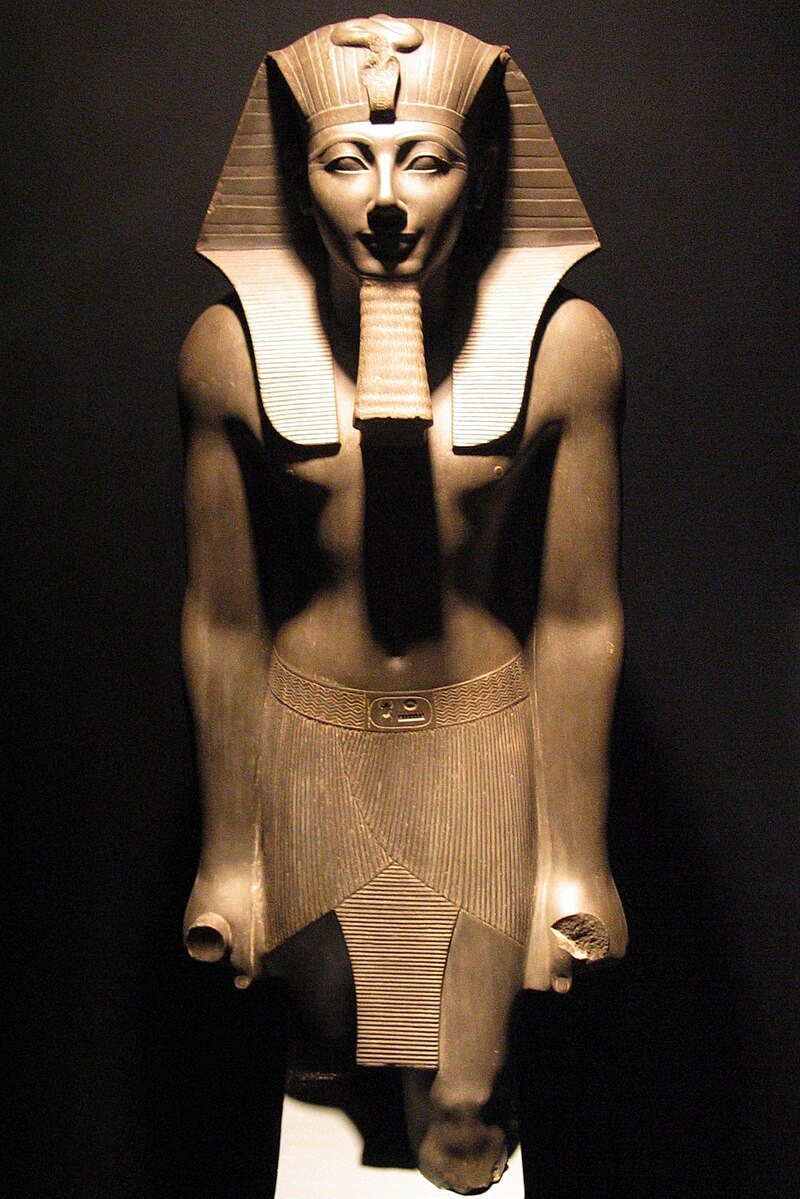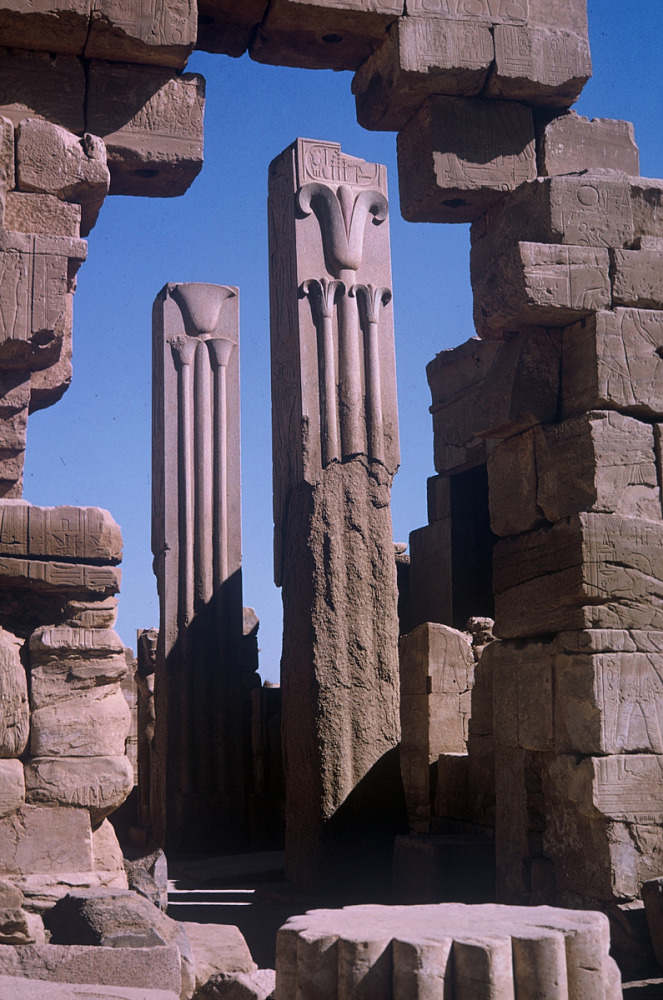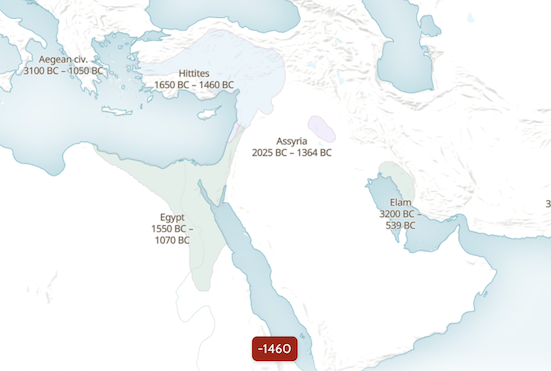Thutmose III
Sculpture Head of Thutmose III exists in the Cairo Museum
Summary
Thutmose III is known today as the Napoleon of Egypt. As Napoleon did, Thutmose conquered widely and also achieved great results administratively. His conquests throughout the Mediterranean (over 15 lifetime campaigns) expanded Egypt to it's zenith and ushered in a period of great luxury which funded feats of decorative art and architecture that are still admired today. For example, the
, still standing today with "astonishingly delicate carving and design"1.Thutmose III was part of the 18th Egyptian dynasty (out of 35 in all). He ruled from 1479 to 1425 B.C. He ruled during the time of Canaan (see Battle of Megiddo2), Phoenicians, Assyrian Empire, Elam, and Hittite Empire, as well as an Aegaen civilization. See
Excerpts From
Page 142
Here at Luxor the lordly Amenhotep III, with the spoils of Thutmose III's victories, began to build his most pretentious edifice; death cam upon him as he finished it in regal style.the perfect "Heraldic Pillars" of Thutmose III, broken off rudely at the top, but still of astonishingly delicate carving and design
Page 143
the Promenade, again the work of Thutmose's builders, with bare and massive colonnades, symbol of Egypt's Napoleon;
Page 154
For twenty-two years the Queen ruled in wisdom and peace; Thutmose III followed with a reign of many wars. Syria took advantage of Hatshepsut's death to revolt; it did not seem likely to the Syrians that Thutmose, a lad of twenty-two, would be able to maintain the empire created by his father. But Thutmose set off in the very year of his accession, marched his army through Kantara and Gaza at twenty miles a day, and confronted the rebel forces at Har-Megiddo (i.e., Mt Megiddo), a little town so strategically placed between the rival Lebanon ranges on the road from Egypt to the Euphrates that it has been the Armageddon of countless wars from that day to General Allenby's. In the same pass where in 1918 the British defeated the Turks, Thutmose III, 3397 years before, defeated the Syrians and their allies. Then Thutmose marched victorious through western Asia, subduing, taxing and levying tribute, and returned to Thebes in triumph six months after his departure
- Allenby took twice as long to accomplish a similar result; Napoleon attempting it at Acre, failed
This was the first of fifteen campaigns in which the irresistible Thutmose made Egypt master of the Mediterranean world. Not only did he conquer, but he organized; everywhere he left doughty garrisons and capable governors. The first man in known history to recognize the importance of sea power, he built a fleet that kept the Near East effectively in leash. The spoils that he seized became the foundation of Egyptian art in the period of the Empire; the tribute that he drained from Syria gave his people an epicurean ease, and created a new class of artists who filled all Egypt with precious things. We may vaguely estimate the wealth of the new imperial government when we learn that on one occasion the treasury was able to measure out nine thousand pounds of gold and silver alloy. Trade flourished in Thebes as never before; the temple groaned with offerings; and at Karnak the lordly Promenade and Festival Hall rose to the greater glory of god and king. Then the King retired from the battlefield, designed exquisite vases, and gave himself to internal administration. His vizier or prime minister said of him, as tired secretaries were to say of Napoleon: "Lo, His Majesty was one who know what happened; there was nothing of which he was ignorant; he was the god of knowledge in everything; there was no matter that he did not carry out". He passed away after a rule of thirty-two (some say fifty-four) years, having made Egyptian leadership in the Mediterranean world complete.
Page 160
After the influx of precious metals that followed the conquests of Thutmose III, merchants began to pay for goods with rings or ingots of gold, measured by weight at every transaction; but no coins of definite value guaranteed by the state arose to facilitate exchange. Credit, however, was highly developed; written transfers frequently took the place of barter or payment; scribes were busy everywhere accelerating business with legal documents of exchange, accounting and finance
page 178
by the time of Thutmose III these documents became full-fledged histories, eloquent with patriotic emotion
page 181
The oldest clock in existence dates from Thutmose III, and is now in the Berlin Museum
page 185
At Karnak and Luxor a riot of columns raised by Thutmose I and III...
page 188
Colossi of Thutmose III and Rameses II began to challenge the skythe basalt statue of Thutmose III in the Cairo Museum;
page 189
At last we bear with equanimity the long reliefs that tell how Thutmose III and Rameses II carried all before them;
page 205
In the year 1380 B.C. Amenhotep III, who had succeeded Thutmose III, died after a life of wordly luxury and display, and was followed by his son Amenhotep IV, destined to be known as Ikhnaton
page 210
Perhaps, as Breasted suggests, this conception of one sole god was a reflex of the unification of the Mediterranean world under Egypt by Thutmose III
page 222
It is almost a law of history that the same wealth that generates a civilization announces its decayWe have a kaleidoscope of this stifling disorder in the "Amarna" letters, in which the kinglets of Babylonia and Syria, having sent modest tributes to imperial Egypt after the victories of Thutmose III, beg for aid against rebels and invaders, and quarrel about the value of the gifts that they exchange with the disdainful Amenhotep III and the absorbed and negligent Iknaton
page 270
The government of Ashurbanipal – which ruled Assyria, Babylonia, Armenia, Media, Palestine, Syria, Phoenicia, Sumeria, Elam and Egypt – was without doubt the most extensive administrative organization yet seen in the Mediterranean or Near Eastern world; only Hammurabi and Thutmose III had approached it, and Persia alone would equal it before the coming of Alexander
page 3000
the tombs of these kings, excavated by the Garstang Expedition, contained hundreds of vases, funerary offerings, and other objects indicating a settled life at Jericho in the time of Hatshepsut and Thutmose III
page 302
Professor Garstang, of the Marston Expedition of the University of Liverpool, claims to have discovered in the royal tombs of Jericho, evidence that Moses was rescued (precisely in 1527 B.C.) by the then Princess, later the great Queen, Hatshepsut; that he was brought up by her as a court favorite, and fled from Egypt upon the accession of her enemy, Thutmose III


